David Rose Gives His Top Prime Rib Cooking Tips Ahead Of The Holidays - Exclusive Interview
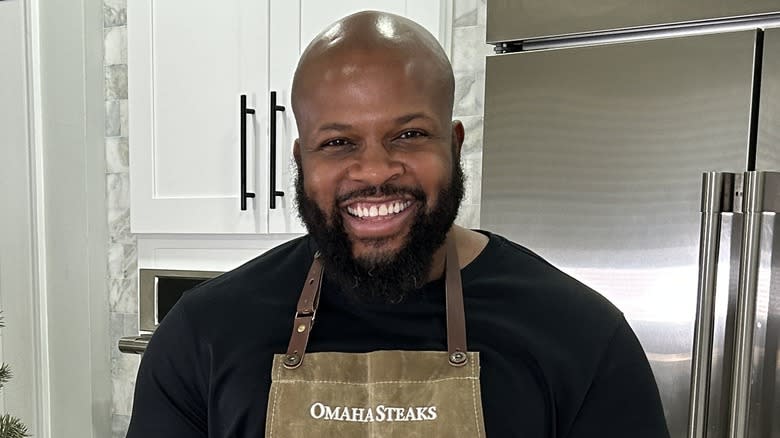
Not everyone cooks a ham or turkey during the holidays. Prime rib does take the spotlight on occasion, and we happened to get some top tips to make it the tastiest roast yet. Mashed spoke to Executive Chef for Omaha Steaks, David Rose, who revealed the dos and don'ts of a delicious holiday meal. Omaha Steaks is well known for its assortment of meats, especially high quality steaks, in stores as well as by mail order.
Rose divulged on the biggest mistake you're making with a prime rib roast, how to create your own compound olive oil, and the next best recipe aside from a beef wellington (ever heard of a deconstructed beef wellington?). The TV personality also has lots of holiday seasoning suggestions that you can use to literally spice up the food on your table — don't underestimate citrus! His answers to our questions will help you make the most of your celebratory meal (and prime rib roast).
Read more: Cuts Of Steak, Ranked Worst To Best
Make Sure To Season A Prime Rib Roast
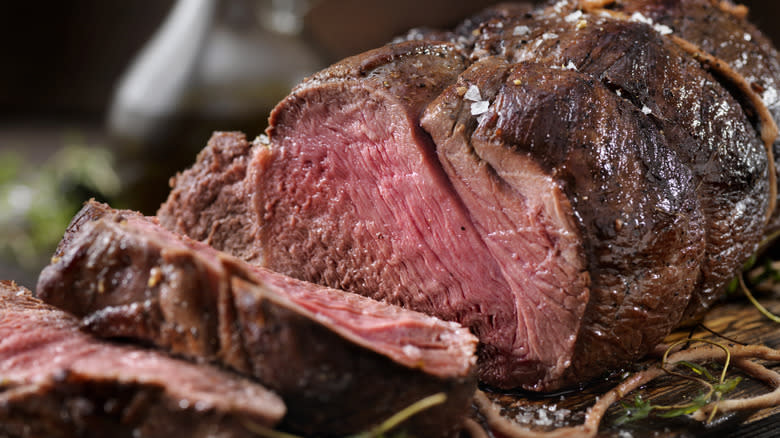
Do you have any cooking tips or tricks for a prime rib roast in terms of a large holiday meal?
Whenever you're doing the prime rib roast, with any large roast or large birds, you want to allow adequate time for it to thaw in the fridge. For a prime rib roast, depending on the size, I like to go at it at least one day for every four pounds of meat, and the same would apply to a large turkey. That's one. Two, you don't want to take it immediately out of the fridge and throw it into the oven. That is a rookie mistake, because you'll have inconsistencies in cooking temperature, it'll take longer to cook, and it won't get that nice, brown coating on the outside -- that delicious GBD (golden brown crust). Allow the prime rib to sit out, minimum, about an hour for it to level out [to] temperature.
With a prime rib roast, do not be afraid to season. Red meats, especially roasts, they love seasoning, so don't be shy. Season very aggressively. Salt and pepper is great, but feel free to get creative because the holidays are about big, bold, delicious, nostalgic flavors. What I like doing sometimes is making a compound oil. Sometimes, I'll use fresh garlic, thyme, rosemary, and sage. I'll mince that all up, and I'll mix it with some olive oil, and I'll give it a coating on the outside of the prime rib that gives it a nice flavor that tends to give it a nice crust [and] help with that golden brown outside of the prime rib.
For novices, especially when it comes to cooking your prime rib roast, they have these really good digital thermometers where you stick it right in the thickest part of the prime rib roast. That way, you're not opening the oven, closing the oven, because you're making your cooking time longer. If you're looking, you ain't cooking ... a digital thermometer always works best.
If you're going for your desired cooking temperature, you don't want to take it out at the ideal temp. Say you want your prime rib at medium, [which] is 140 to 145. You don't want to take it out at 140 or 145, because it's going to carryover cook, and that means it's going to increase about five to 10 degrees so by the time it rests and carryover cooks, so it'll be more towards the medium well side of things.
If you want it medium, you want to take it out at medium rare. At 130, take it out, let it rest for about 15, 20 minutes. That way, when it gradually climbs, it'll be that perfect medium temperature. The same applies for rare and medium rare. We're not going to talk about well done. If you get into prime rib, medium is the most I would do with it.
I just made a turkey and I made sure the temperature... I was looking at it, looking at it, and then it rose when I took it out and it was a little drier than I thought. Now I know.
You want to take [turkey] out at 160. The turkey breast, poultry, 165 is the safe temperature for it to be cooked. 160 carryover cooks to that perfect 165 for juicy turkey every single time.
Don't Forget About Compound Olive Oil
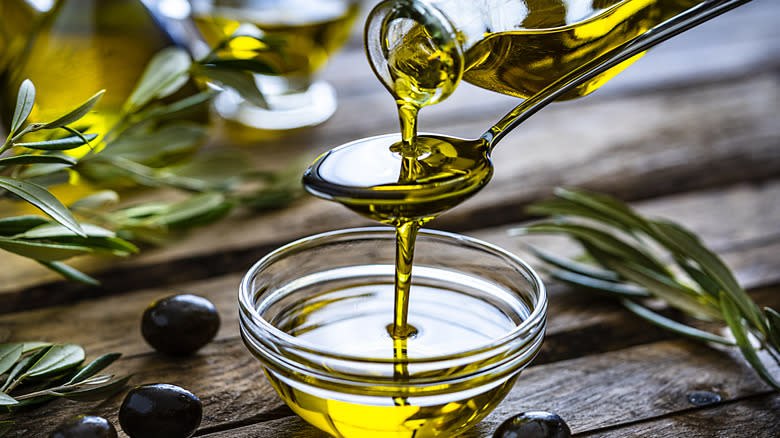
The olive oil is interesting to me, because normally it's like a compound butter situation. How does the olive oil aid a prime rib roast in terms of flavor?
With olive oil or even grapeseed oil, [they have] a higher smoke temperature. When I say smoke temperature, what that means is the temperature in which it'll get bitter and acrid and start to burn. You don't want that. A lot of times, especially with butter, depending on how you're doing it, whether you're searing before or after, the butter can burn because it has a pretty low smoke temperature. That's why, especially for a novice, I suggest olive oil or grapeseed oil to deter and give you as little chance as possible of that burning.
I make it with the grapeseed oil or olive oil and then I make that compound butter, and when it's resting, I put that compound butter on there and let it rest as well. You get twofold. You get the compound oil with the herbs and the garlic, and then let it rest where that butter then melts into all those pores and crevices of the prime rib, and it's truly something exceptional.
Do you have any tips for reheating and repurposing leftover rib roasts? Normally with the holidays, you get a lot of leftovers and you don't know what to do with it.
I definitely like to keep all of those delicious, glorious pan drippings. I make a jus or a gravy out of that, and then I'm making prime rib sandwiches. French dip all day long -- that's what I'm doing with that. Sometimes, I like dicing it up in big chunks and making an omelet or a frittata or scrambled eggs. [You can also] just heat it up, a big old hunk of slab, and heat it up slowly so it's not overcooking, and then just eat it as is. I'm all about a multipurpose prime rib roast after the holidays.
When heating it up, would you recommend using the stove top versus microwave, or both?
Microwave, no. The only thing that the microwave is good for, in my opinion, is microwave popcorn. Always use the oven and stove top whenever you can. If you're trying to do a larger roast, I'd probably put it in the oven, maybe 225, 250, so it creeps up and you're not overcooking it. If it's trying to do a steak, slice that nice hunk off and use a nice, rip-roaring cast iron pan to get that steak to room temperature. At that point, sear. It's already at the temperature you made it before.
When it comes to roast, steaks, and red meat, I stay far away from [microwaves]. I like to use the oven or a cast iron. That's the great thing about food and cooking; there are a million different ways to do it. For me, that's what works best, so I stay to that tried and true procedure and those steps right there.
Deconstructed Beef Wellington Is The Next Best Thing

If you want to serve a fancy steak dish along the lines of a beef wellington, but you don't necessarily have time to pull that off or you're a novice at cooking, what would you recommend doing?
If anything, you could have all those flavors of a beef Wellington -- the duxelles, which is the minced mushrooms, shallots, garlic, those fresh herbs in there -- you could do that. Have the Chateaubriand, roast that off, sear it off, let it roast, and then you could put the duxelles on the side. If you want to take it a step further, maybe do little circles where you're doing individual circles of puff pastry, then compile and build their own beef Wellington, as opposed to slathering it with the duxelles, wrapping with the puff pastry and say, "It's deconstructed beef Wellington."
That makes it 10 times easier. I've never attempted beef Wellington.
You got it. It's not as hard; it's just the preparation. It's not a lot of steps, but you've got to make sure that you have the correct steps along the way.
Do you have any holiday-specific seasoning recommendations for steak, incorporating seasonal kinds of spices?
For a great steak, especially Omaha Steaks, all you need is salt and pepper. The great thing about holidays, there's some really great flavors and aromatics and spices that lean heavily towards that. I like to lean towards thyme, rosemary, sage, those things really pull back and give me that nostalgia of Thanksgiving. Incorporating those into simple rubs, maybe some crushed garlic, some crushed onion, shallots, stuff of that nature to where you're really amplifying and bumping up those flavors that make you think of holidays.
Thyme and rosemary are two big ones for it. This is in the same vein, but what about holiday-specific seasoning recommendations for that compound butter that you're going to put on that?
One of my go-tos is you always want to use unsalted butter. That way, you can control the salt content, because you could always add salt, but you can't take it out. Roasted garlic -- I like doing the whole bulb, put it in the oven until it's nice and roasted and tender. Then, I take that out, and I crush that and mash that. I then mince up some rosemary, I mince up some thyme, sage, maybe oregano, and in there I do salt, pepper, a little bit of crushed red pepper or Calabrian chili, and whip that up.
It's savory, a little bit of spice, a little bit of sweet, a little bit of heat and super flavorful and pairs well with pork, steak, literally anything. It's a cross-platform kind of butter where you can use it for anything at the Thanksgiving dinner table.
In terms of ratios for that compound butter, how much do you normally put in for the spices or seasonings?
I'd say it's about a half a pound ... I like garlic. To hell with the breath after. I love garlic. Garlic is great. It's an amazing, great flavor. I do about four to five cloves of that garlic in there. As far as seasoning, I'll start out with a teaspoon and then see where it goes from there.
As far as the herbs, about a tablespoon of each. Depending on heat, if you like a little more heat, I'd probably say the tablespoon area of the Calabrian chili. If it's crushed red pepper, a little spicier, a little more concentrated, maybe a teaspoon of that. If you're doing seafood, maybe a little bit of lemon zest in there to brighten that up as well.
Citrus is a great way to cook.
It is great. Orange, lemon, all of it.
How To Defrost Raw Steak
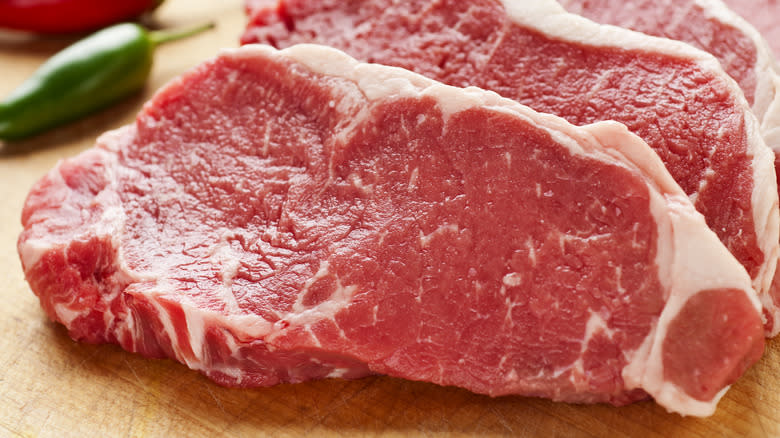
What would be your special tips for freezing and defrosting raw steak?
You always want to do a gradual thaw. What I like doing is putting in the larger roast, like your prime rib, Chateaubriand, for a couple of days, allowing for that four pounds per day. If you have to quickly thaw it, you can submerge it in water.
Ideally, you want to let that meat come up with temp. You let it thaw out in the fridge overnight or a couple days for the larger roast. The most important part: You always want it to come to room temperature so you have consistent doneness throughout the steak, roast, or Chateaubriand.
Do you put it in the fridge?
Yes. I take it out of the fridge once it's fully thawed and let it stand right here on the counter at room temperature. For smaller steaks, I do 30, 25 minutes. For larger roasts like your prime rib or Chateaubriand, I do about an hour. It's going to make all the difference.
What do you think are some of the biggest mistakes people make when cooking a cut of meat like Wagyu?
Yes. Wagyu is the beef from the gods. Delicious, great, savory, buttery deliciousness. You don't want to overcomplicate it, especially with Wagyu, so salt and pepper. You don't want to overcook it. Very simple, very easy. I wouldn't overdress or over-season or add too much to the Wagyu, because the Wagyu itself is amazing, so don't over complicate it. Use a quick sear on there. Ideally, you want to serve that rare to medium rare, so you can taste the beautifulness of the Wagyu.
The Perfect Way To Make Brussels Sprouts
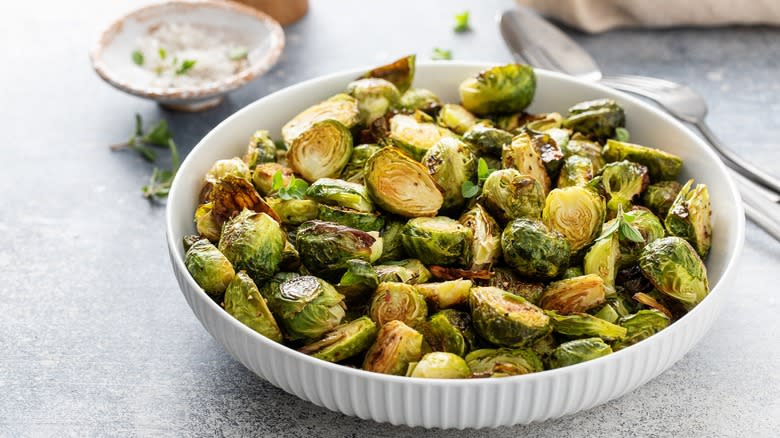
Ehat do you think are the best side dishes to pair with a steak?
You can't go wrong with some nice garlic mashed potatoes, baked potato, and gratin. Potatoes lends very well towards meat. Brussels sprouts, green beans, asparagus, a nice sauce -- Bearnaise, Hollandaise, jus, or gravy. All those things lend very well to it. Spinach — can't get wrong with that.
For the Brussels sprouts ... I know some people flash fry them. How do you recommend cooking them for a simple recipe?
What I like doing is to go in and blanche them, because there's nothing worse than a crunchy Brussels sprout. I blanch them for about two minutes to get a kickstart on the cooking process. I slice them in half. Then, I put garlic, bacon, olive oil, salt, and pepper into a hot oven. A good cheat is getting that cast iron pan or that sheet pan hot already. You're preheating it. That way, when it hits the pan, it's getting a nice sear and brown caramelized base on there. That's what I do. Simple is easy. Garlic, bacon, salt, pepper, olive oil -- can't go wrong.
With a side dish like creamed corn, do you have any ideas on how to upgrade that classic dish?
Definitely with cream corn, there's different ways. I like to put coconut milk in there. It gives it a nice sweetness as opposed to heavy cream. I like putting bacon in there sometimes. If you like a little heat, a little crushed red pepper, a little bit of Aleppo pepper [or] Calabrian chilies. If you want that elote feel, jazz it up a little bit, do the same thing, but finish it off with some lime zest on top or a little bit of that cotija cheese on top, get a nice grill on it. With food, especially traditional dishes like that, to keep it exciting, new and refreshing, switch them up and add different things here and there, but it still remains true to the spirit of the dish.
Lime zest is interesting. Because we were talking about citrus before, would you add that to a type of meat or do you think that would not be ideal?
Yeah, for sure. Definitely. Citrus lends very well to seafood and poultry, too. If I am going to use it with roast or beef, a very dash amount of it, make sure it's balanced. More than anything else, make sure it's balanced where it's not too much of anything. Take your steps. Do it gradually. Less is more. That way, you're not adding too much of something at a time.
Keep up with Chef David Rose on Instagram. Check out Omaha Steaks website to learn more about their offerings.
This interview has been edited for clarity.
Read the original article on Mashed.

